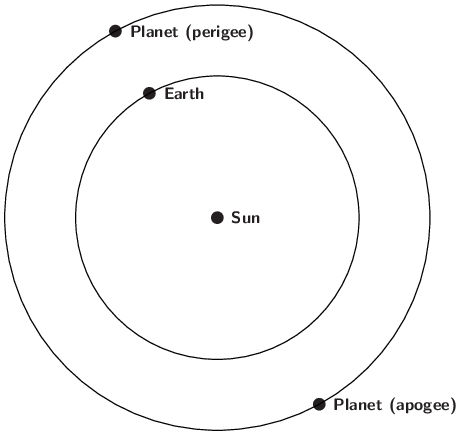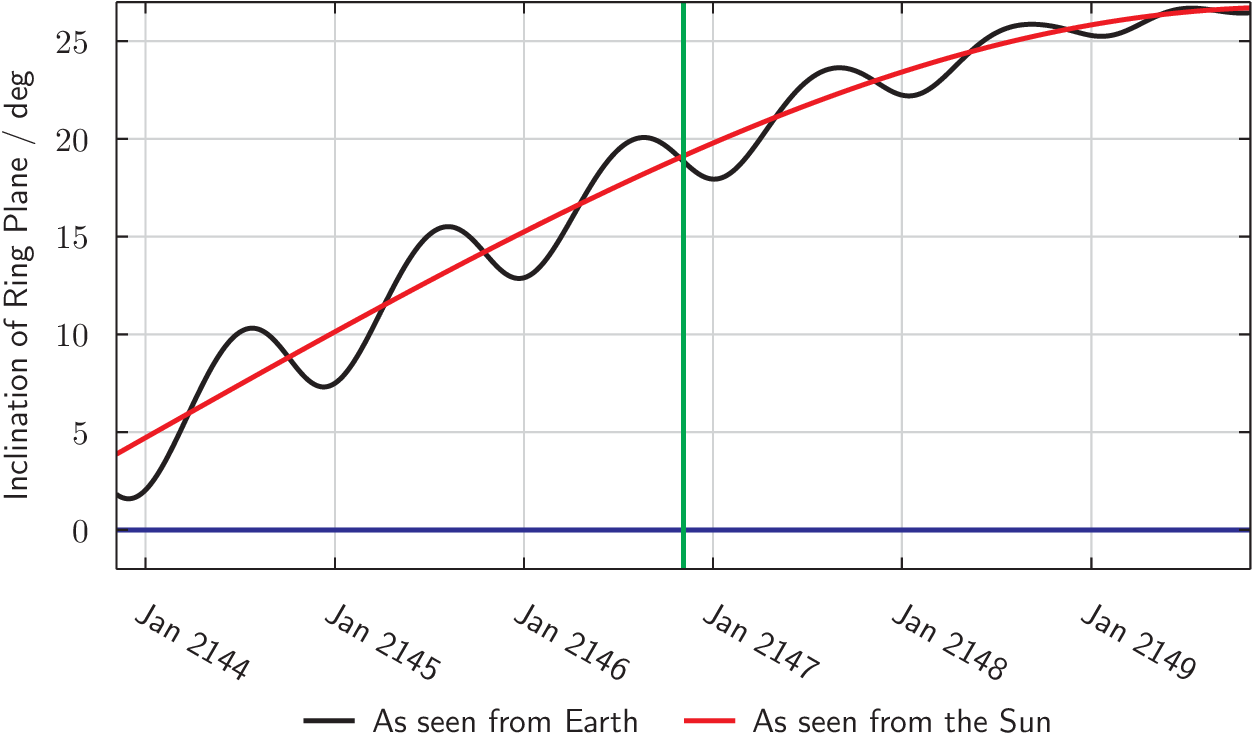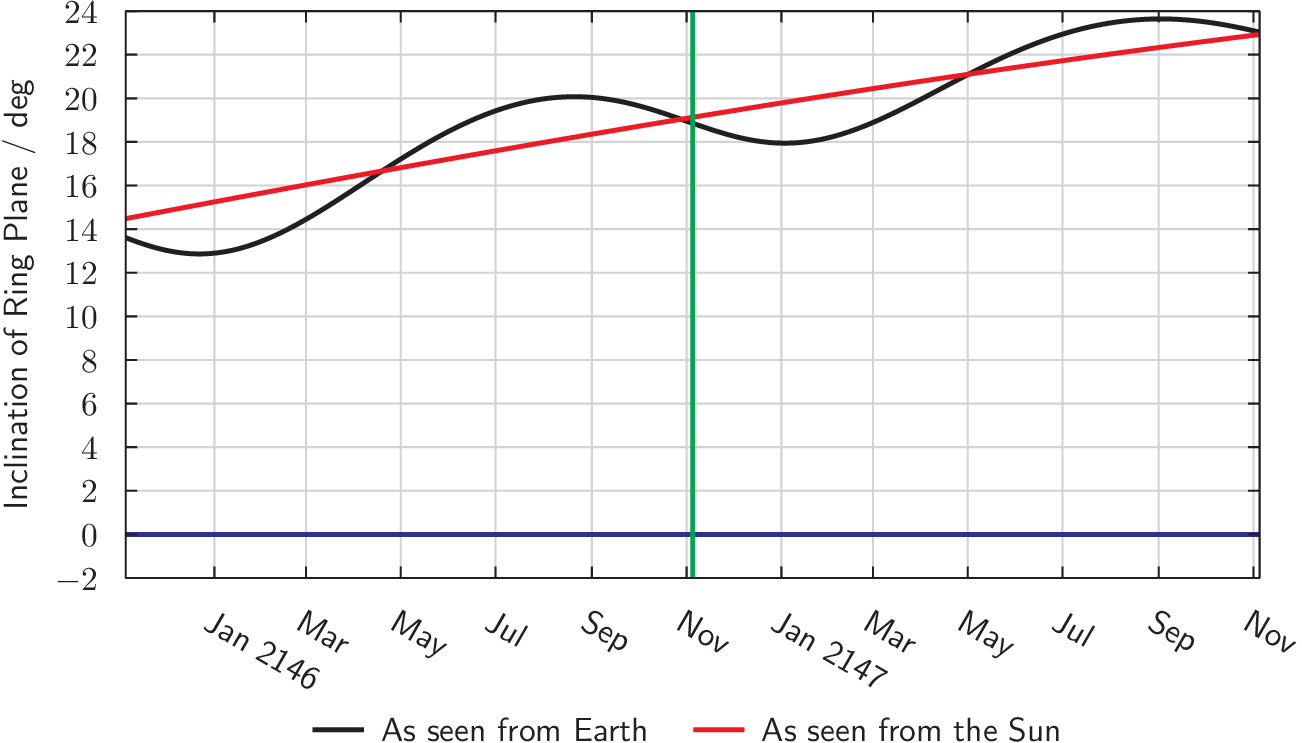Saturn will reach opposition – the optimal time to observe it, when it will be visible for much of the night in the constellation Aries.
From South El Monte, it will be visible between 18:46 and 06:20. It will become accessible at around 18:46, when it rises to an altitude of 9° above your eastern horizon. It will reach its highest point in the sky at 00:33, 68° above your southern horizon. It will become inaccessible at around 06:20 when it sinks below 9° above your western horizon.
A close approach to the Earth

When a planet is at opposition, the solar system is aligned with that planet on the same side of the Sun as the Earth.
The term opposition refers to the moment when a planet passes opposite to the Sun in the sky. For those planets which orbit the Sun at a greater distance than the Earth – like Saturn – this geometry occurs as the two planets pass each other in their orbits and they make closest approach – termed its perigee.
At opposition / perigee, planets are visible for much of the night, reaching their highest point in the sky around midnight local time, just as the Sun, 180° away, dips to its lowest point below the horizon.
Because it passes closest to the Earth at this time, the planet also appears at its brightest and largest around opposition.
The panels below show a comparison of the apparent size of Saturn when seen at opposition in 2146, and when it is most distant from the Earth at solar conjunction.
In practice, the variation for Saturn is quite modest since it orbits much further out in the solar system than the Earth – at an average distance from the Sun of 9.54 times that of the Earth. Consequently, its distance and angular size does not vary much as it cycles between opposition and solar conjunction. The variation is much greater for Mars, since it lies much closer to the Earth.
A comparison of the size of Saturn as seen at 2146 opposition and at solar conjunction.
The rings of Saturn
Saturn will be angled to show its southern hemisphere at this opposition, and the rings will inclined at an angle of 18° to our line of sight, making them very well presented.
The graph below shows the changing inclination of Saturn's rings over time. The black line indicates their inclination to our line of sight from the Earth. A negative angle indicates that the north pole is tipped towards us, while a positive angle indicates that we see the south pole. An angle close to zero means that Saturn's rings appear close to edge on.
The red line indicates the inclination of the rings to the Sun's line of sight to the planet. Interesting phenomena can occur when the rings are very close to edge-on, if the Sun illuminates one side of the rings, while we see the other. At such times, we see the unilluminated side of the rings.
The Seeliger Effect
For a few hours around the exact moment of opposition, it may be possible to discern a marked brightening of Saturn's rings in comparison to the planet's disk, known as the Seeliger Effect.
This occurs because Saturn's rings are made of a fine sea of ice particles which are normally illuminated by the Sun at a slightly different angle from our viewing angle, so that we see some illuminated particles and some which are in the shadow of others.
At around the time of opposition, however, the ice particles are illuminated from almost exactly the same direction from which we view them, meaning that we see very few which are in shadow.
Observing Saturn
At opposition, Saturn is visible for much of the night. Even when it is at its closest point to the Earth, however, it is not possible to distinguish it as more than a star-like point of light without the aid of a telescope.
A chart of the path of Saturn across the sky in 2146 can be found here, and a chart of its rising and setting times here.
At the moment of opposition, Saturn will lie at a distance of 8.21 AU, and its disk will measure 20.2 arcsec in diameter, shining at magnitude -0.2. At opposition, its celestial coordinates will be:
| Object | Right Ascension | Declination | Constellation | Magnitude | Angular Size |
| Saturn | 02h35m00s | 12°23'N | Aries | -0.2 | 20.2" |
The coordinates above are given in J2000.0.
Over the weeks following its opposition, Saturn will reach its highest point in the sky around four minutes earlier each night, gradually receding from the pre-dawn morning sky while remaining visible in the evening sky for a few months.
The sky on 22 Dec 2025
| The sky on 22 December 2025 | ||||||||||||||||||||||||||||||||||
|
10% 3 days old |
All times shown in PST.
|
|||||||||||||||||||||||||||||||||
Source
The circumstances of this event were computed using the DE430 planetary ephemeris published by the Jet Propulsion Laboratory (JPL).
This event was automatically generated by searching the ephemeris for planetary alignments which are of interest to amateur astronomers, and the text above was generated based on an estimate of your location.
Related news
| 04 Nov 2146 | – Saturn at opposition |
| 10 Jan 2147 | – Saturn ends retrograde motion |
| 11 Sep 2147 | – Saturn enters retrograde motion |
| 18 Nov 2147 | – Saturn at opposition |
Image credit
© NASA/Cassini




